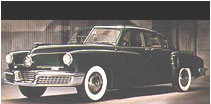If the history of the Volkswagen Beetle were presented as an imaginary tale, no one would believe it was plausible.  What is now the most famous car the world has ever known suffered so many false starts and survived so much hardship, that it is difficult to imagine a harder road to victory. Yet, somehow, the Volkswagen Beetle not only endured but prospered. Read more . . .
What is now the most famous car the world has ever known suffered so many false starts and survived so much hardship, that it is difficult to imagine a harder road to victory. Yet, somehow, the Volkswagen Beetle not only endured but prospered. Read more . . .
Was Preston Tucker a visionary or a charlatan, a promoter or a huckster, a sinner or a saint?  Five decades after he introduced his great car upon an unsuspecting public, those questions are impossible to answer. But the fact is, he was possibly all of these things and more, for the story of Tucker and his Torpedo is the story of America in the wonderful, dreadful aftermath of World War II. It’s the story of hoping against hope and daring to be different and,finally, the story of failure either unfairly thrust upon him or richly deserved. Read more . . .
Five decades after he introduced his great car upon an unsuspecting public, those questions are impossible to answer. But the fact is, he was possibly all of these things and more, for the story of Tucker and his Torpedo is the story of America in the wonderful, dreadful aftermath of World War II. It’s the story of hoping against hope and daring to be different and,finally, the story of failure either unfairly thrust upon him or richly deserved. Read more . . .
Nobody ever accused Maxwell Smart (alias Agent 86) of being the brightest gemstone in the jewelry box, but there is one thing you can say for him, he knew how to pick a car. When he cruised up to the clandestine offices of Control each week to get his newest assignment, the Sunbeam Tiger he left at the curb drew knowing smiles from teenage auto freaks in the television audience (as well as one Jack R. Nerad of LaGrange, Illinois.) Read more . . .
If a classic American trait is confidence, then Harry C. Stutz was as American as apple pie or baseball. A more confident car guy you are never likely to find, and, to his everlasting credit, Stutz always backed up his confidence in himself with superior quality work.
Born on a farm near Dayton, Ohio, on September 12, 1876, Stutz was only able to achieve a grade-school education before he entered the work force, landing a job at the Davis Sewing Machine Company and then moving on to the National Cash Register Company. Stutz wasn’t the type to sit still, despite the long hours. At night, he took classes in mechanical engineering, and by 1897 he had designed and built his first car, a contraption nicknamed “Old Hickory” because it was built from a discarded hardwood buggy and scrounged parts. Read more . . .
Often the best-laid strategies of men and women go awry, but sometimes plans that were conceived as no more than stop-gap measures do work far better than their planners expect. This was the case with the Land Rover.
work far better than their planners expect. This was the case with the Land Rover.
In 1946, Britain was still feeling the devastating effects of World War II. Its businesses were in shambles; its supplies of raw materials drained; and its forward progress at a standstill. To survive and flourish, Britain’s car companies were forced to make do with what little they had available. In that spirit, Maurice Wilks, Rover Managing Director, looked at the U.S. Army surplus Jeep he had just acquired and said to himself, “We need to build something similar to this, only better.” He envisioned a growing market for such a vehicle, both in Britain and in export markets around the globe. Read more . . .
- « Previous Page
- 1
- …
- 6
- 7
- 8
- 9
- 10
- …
- 18
- Next Page »